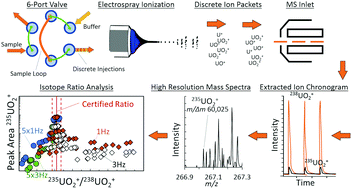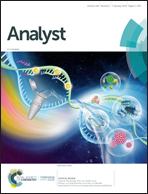Considerations for uranium isotope ratio analysis by atmospheric pressure ionization mass spectrometry†‡
Abstract
The accurate measurement of uranium isotope ratios from trace samples lies at the foundation of achieving nuclear nonproliferation. These challenging measurements necessitate both the continued characterization and evaluation of evolving mass spectrometric technologies as well as the propagation of sound measurement approaches. For the first time in this work, we present the analysis of uranium isotope ratio measurements from discrete liquid injections with an ultra-high-resolution hybrid quadrupole time-of-flight mass spectrometer. Also presented are important measurement considerations for evaluating the performance of this type and other atmospheric pressure and ambient ionization mass spectrometers for uranium isotope analysis. Specifically, as the goal of achieving isotope ratios from as little as a single picogram of solid material is approached, factors such as mass spectral sampling rate, collision induced dissociation (CID) potentials, and mass resolution can dramatically alter the measured isotope ratio as a function of mass loading. We present the ability to accurately measure 235UO2+/238UO2+ down to 10s of picograms of solubilized uranium oxide through a proper consideration of mass spectral parameters while identifying limitations and opportunities for pushing this limit further.



 Please wait while we load your content...
Please wait while we load your content...